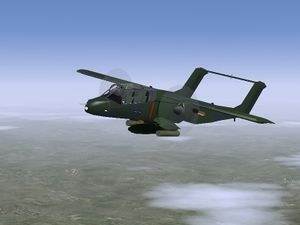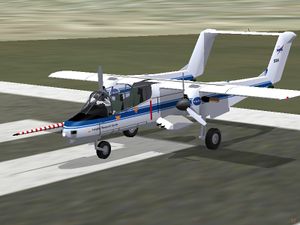North American OV-10A Bronco
 | |
|---|---|
 OV-10A USAFE | |
 OV-10A cockpit | |
| Type | Military aircraft, Civil aircraft, Multirole aircraft |
| Configuration | Twin boom aircraft, High wing aircraft |
| Propulsion | Turboprop aircraft, Twin-engine aircraft |
| Manufacturer | North American Aviation |
| Author(s) |
|
| FDM | JSBSim |
| --aircraft= |
OV10_CDF OV10_NASA OV10_USAFE OV10_BlkPony |
| Status | Production |
| Development | |
| Website |
|
| Repository |
|
| Download |
|
| License | GPLv2+ |
| Wikipedia |
North American Rockwell OV-10 Bronco |
|
| |
The OV-10 Bronco (North American, Rockwell) is a 2 turboprop plane for FlightGear is available for 0.9.10 and 1.0.0. The OV-10 model was worked on and used by the OV-10 Bronco Association Museum Simulator Project, in a custom simulation installation at the OV-10 Bronco Museum. (see Here).
The OV-10 package for FlightGear contains three versions of the airplane: A U.S. Air Forces Europe version, which models an OV-10A assigned to the 601st Tactical Control Wing at Sembach Airbase, Germany; A California Department of Forestry version, used for fire fighting command and control; and a NASA version, used for atmospheric and aerodynamic research. Each model not only features customized exterior texture, but also relevant changes to the 3D models, and flight systems.
About the aircraft
"The North American Rockwell OV-10 Bronco is a turboprop-driven light attack and cargo aircraft. Although it is a fixed-wing aircraft, its mission capabilities resemble a fast, long-range, inexpensive and reliable ultra-heavy attack helicopter. It flies at 244 knots (452 kilometers/hour), carries 3 tons of external munitions, and easily loiters for 3 or more hours. It is prized for its versatility, redundancy, load, wide field of view, short-field ability, low operational costs and ease of maintenance."
"The OV-10 has been used by the United States' Air Force, Marines and Navy, the military forces of several other nations, and the U.S. Customs Service, Bureau of Land Management, NASA and California Department of Forestry. There is at least one airplane in private hands as well. "
User's Manual
The FlightGear OV-10 features a user-selectable "easy mode". By default the airplane starts in "easy mode".
Starting procedure
To start the engines (not necessary in the easy mode) switch the current view to the engine panel view and:
- switch on the Engine 1 start switch
- switch on the Engine 2 start switch
Once they are started the switches fall back to the RUN position and you can hear the engines RPM go up. When the RPM stabilizes the engines are at idle and ready for take off.
Armament procedure
To charge the guns (not required when in "easy mode"):
- Guns LH and RH switches .......... READY
- Master Arm switch ................ ON
- Trigger .......................... Squeeze
- Master Arm switch ................ OFF
To fire the guns:
- Master Arm switch ................ ON
- Trigger .......................... Squeeze
WARNING: The Master Arm switch should be set to the OFF position bewteen firing passes.
To Fire a rocket:
- Appropriate station switch ....... FIRE
- Master Arm switch ................ ON
- Weapons release button ........... Push
CAUTION: The rocket pod may be set for SINGLE or RIPPLE fire, and is not selectable from within the cockpit. CAUTION: If the station switch is mistakenly set to DROP, the entire rocket pod will be dropped.
To drop a bomb:
- Appropriate station switch ....... DROP
- Fuse switch ...................... Select NOSE or TAIL
- Master Arm switch ................ ON
- Weapons release button ........... Push
Dimensions
- Span: 40 feet (12.2 meters)
- Length: 41 feet, 7 inches (12.7 meters)
- Height: 15 feet, 1 inch (4.6 meters)
- Weight: Empty: 7,190 pounds (3,261 kilograms)
- Maximum take-off gross weight: 14,444 pounds (6,552 kilograms)
Note that the sponsons (the small winglets attached to the fuselage) can be removed, as the CDF did with their OV-10's. The fuselage rear cargo door could also be removed, as was necessary when dropping paratroopers. The Air Force models did not carry the mid-wing weapons racks, and although the AIM-9 control box remained in the cockpit, the AIM-9 system was deactivated.
Performance
- MAXIMUM SPEED AT SEA LEVEL: 244 knots (452 kilometers/hour). This published number may be for a very light airplane with sponsons removed. In a more standard configuration, with a 230 gal. external fuel tank, the OV-10A would do about 180 knots indicated on a very hot day, and 220 knots on a very cold day.
- SERVICE CEILING: 28,800 feet (8,778 meters), but regulations limited the ceiling to 25,000 feet due to lack of cockpit pressurization.
- CREW: One pilot and optionally one observer (removable rear seat for greater fuselage cargo capacity).
- FUEL: Five self-sealing fuel tanks in wing: 252-gallon capacity (954 liters) 150-, 230-, or 300-gallon (568-, 871-, or 1,136-liter) external tank.
- RANGE: 700 nautical miles (1,297 kilometers) with internal fuel 1200 nautical miles (2224 kilometers) with 150-gallon (568-liter) drop tank.
- MISSION PERFORMANCE: 5.5 hours loiter time with 150-gallon (568-liter) drop tank50 nautical miles (93 kilometers) and 2 hours loiter time with full ordnance load.
- MAXIMUM DIVING SPEED: 350 knots.
Special Features
Fuel System
Internal Fuel System
- 5 wing stored tanks gravity fed to the engines (fuel cutoff after 15 consecutive seconds of negative G flight).
- default tanks if external is empty or not used.
External Fuel System
- 1 230 gallons external tank fixed to external station 3, pump fed. If the pump is still activated and the tank is empty or has been dropped the pump will fail after 15 minutes, an orange light turns on on the upper right corner of the panel when pump output pressure is low .
Armament
(Read the armament procedure in the User's Manual section)
- 4 M60C 7.62mm machine guns, two in each sponson (shoot tracers, 500 rounds).
- 2 Mk82 500lbs bomb, with either nose or tail (delayed) fuse.
- 2 LAU68 2.75in rocket pods, with single or multiple fire sequence (7 rockets in each pod).
Station Load:
- Station 1: LAU68 (single fire mode).
- Station 2: Mk82.
- Station 3: External Fuel tank.
- Station 4: Mk82.
- Station 5: LAU68 (ripple fire mode).
The weight of each weapon is figured into the Flight Dynamics Model, however drag effects are not yet modeled. The gunsight is fixed at present. We hope to add adjustable sight depression in the future. Note that the weapons, when released, are AI models, and as such do not know the terrain elevation. This means it is not yet possible to mark the point of impact. This ability may be added to FlightGear in the future.
The trigger on your joystick is not set up to be a trigger if you are using the default FlightGear joystick bindings. The OV-10 model will automatically re-bind your keyboard "space" key for use as a weapons release button.
Radar Detector
- 1 AN/ALR 46 Radar detection system
Misc.
- right engine smoke created by mixing oil into fuel thus making a white smoke (s to trigger, S to stop).
- Parachutists: in the Air Force version press the 'j' key to drop five parachutists from the rear of the airplane.
- Ejection Seat: in the Air Force version press the 'e' key to eject.
Available Versions
- US Air Force Europe (USAFE), from the 601st Tactical Control Wing, based at Sembach Airbase, Germany from about 1976 to 1984, used as forward air control, light attack, observation and utility roles.
- California Department of Forestry (CDF), used for fire detection and combat.
- NASA, used for atmospheric research.
Development status/ToDo
Outside:
- full 3D model complete
- fully animated
- fully textured
- external models: 230gal fuel tank, Mk82 bomb, rockets, parachuters, ejection seat/parachute
Cockpit:
- All versions now have a 3D cockpit
- most instruments present
- realistic fuel system implemented
- working weapons and external stations release
TODO:
- finish 3D cockpit
- add ignition sequence
- add radar detection system (AN/ALR-46)
(!) all the 3 versions in the new release have the same name in the aircraft selection list (US airforce 0V-10 etc.)
(!) landing gear hangs in the air, when aircraft is on the ground
(!) please, add the navigation and communication systems description to this operating manual
External links
OV10A Bronco development project
OV10A Bronco technical specifications
OV-10 Project information at FlightGear.org
Wikipedia's article on OV-10 Bronco
| |||||





